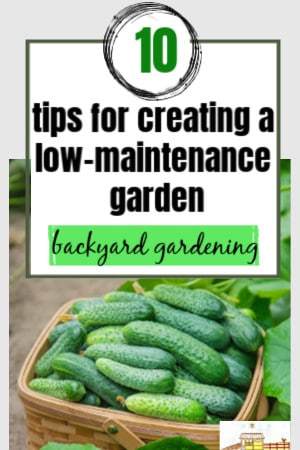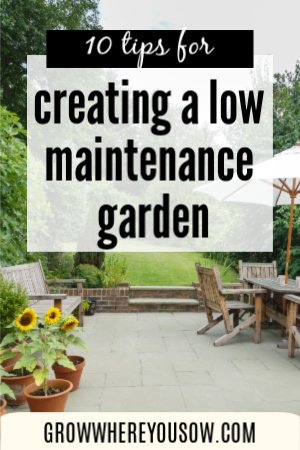10 tips for creating a low maintenance garden
A low maintenance garden is an appealing thing. I work a full-time job and run a blog, on top of gardening and keeping a household tidy (most the time at least). We all wouldn’t mind saving a little time in the garden, busy schedules, or not. Here are a few tips for creating and keeping a low maintenance garden, saving time on pulling weeds and watering.

Table of contents
When you have a busy schedule or work a full-time job, it can be helpful to have a low maintenance garden and easy upkeep.
Gardening doesn’t have to take up all of your time. There have been studies proving that getting your hands dirty is great for you. But the time it takes to grow a successful garden sometimes feels like far too much. It doesn’t have to be that way.
Mulching for a low maintenance garden
Mulching is wonderful for so many reasons, starting with suppressing weeds. I’m in Central Florida and the weeds here are Frankenstein weeds! They grow deep and they grow plentiful.
Mulching to keep the weeds at bay, and if I’m lucky non-existent, meaning that I get to spend less time fighting to pull them!
Additionally, mulching preserves the health of your soil by protecting it from the sun and keeping it cool and moist, allowing your plants’ roots to reach deep and stay hydrated and healthy.
Companion planting
Practicing companion planting is a great way to avoid pests in the garden. This summer season of 2020, we had a serious pickle worm problem on our zucchini. We actually pulled all our plants up *sigh*.
Since the caterpillars mostly come out at night to feast on the crops, I was going out and spraying my crops at night with BT (which is safe for organic gardening).
Let’s face it, this is the exact opposite of a low maintenance garden setup. It was exhausting. By companion planting, you can naturally work towards preventing pests which means it’s less likely you’ll be spending time picking caterpillars off your zucchini plants or spraying them with BT late at night.
Creating compost
Composting helps mostly in the long run because it means no more trips to the store to add nutrients to your garden. I suggest hot composting in order to produce compost quicker, but the decision is completely up to you. It mostly matters on how much space you have.
Build raised beds
It’s so much more convenient to have garden beds a little higher off the ground for easy maintenance. It’s also a little more simple to control the soil composition in a raised bed, although some will say you do have to add more nutrients than when ground gardening.
For our situation, raised bed gardening has been the best because we stack thick layers of cardboard in the beds before adding soil. This means that weed activity is kept to a minimum, save me (and my back) time and energy.
Garden in containers
Container gardening is a wonderful garden method for small spaces and folks who need a more controlled environment. Container gardens can be moved around your yard as needed, meaning season to season you can position your plants for more or less sun, therefore leading to healthier crops!
We have added hoop shades to our raised bed gardens and, although it was a one-time thing, it was more money and time that had to be invested in my garden. If you have less time on your hands, that might not be ideal.
Plant drought-tolerant crops
By planting drought-tolerant or drought-resistant crops, you’re increasing the likelihood of a low maintenance garden because you’re watering less!
Among crops labeled as drought-tolerant/resistant are corn, okra, and some varieties of beans. There are great resources on the web that will tell you exactly what crops and varieties are good for your area, like this one for California.
Invest in growing perennials
What saves more time than not having to even sow the seeds to grow your garden? We have a few great asparagus beds that are the most low-maintenance gardens on our homestead.
We re-mulch them every other season to keep weeds at bay and just clip the dead stalks when needed. They are so low-maintenance that I actually forget they exist outside of the season!
Garden with a neighbor
I’m not even kidding here! Think about a community garden. You have multiple people pitching in to water, weed, pull diseased crops, etc. It can be beneficial to receive help from folks who would also like to benefit from the bountiful crop.
If you have a little space but aren’t sure your neighbor does, see if they’d be interested in a team-effort, low maintenance garden.
Don’t over-garden
One of the biggest mistakes you can make it planting too many crops. When creating your garden space, keep in mind what you can handle. Even more important, when you are planting your garden keep in mind that every crop that grows will need to be harvested, prepare, or even preserved.
Plant what you know you’ll need, and no more, unless you have the time to spend on tending to the crops. Waste not, y’all. Here’s a handy calculator to try and decide how much to plant!
Grow your garden closer to your home
Last, create your garden closer to home. If you have to trek all the way out to the garden space, that means you’re spending more time commuting to your garden than doing chores to maintain what should be a low-maintenance setup.
You can grow a “kitchen garden”, which is simply a garden outside the kitchen. This way you can harvest the vegetables you want, when you need them, while not spending to much time doing so.


Thank you, for sharing! We are restructuring our gardens. We both work full time and are in our 50’s so low maintenance is becoming more and more important. This was a very timely post for me!
Hi Anne! I’m so glad you enjoyed my post and hope you found a few helpful pieces of advice. I totally understand needing a little more time! Keep moving forward – you’re doing great!